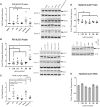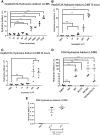The Isoniazid Metabolites Hydrazine and Pyridoxal Isonicotinoyl Hydrazone Modulate Heme Biosynthesis
- PMID: 30517741
- PMCID: PMC6390808
- DOI: 10.1093/toxsci/kfy294
The Isoniazid Metabolites Hydrazine and Pyridoxal Isonicotinoyl Hydrazone Modulate Heme Biosynthesis
Abstract
In a mouse model, rifampicin and isoniazid combination treatment results in cholestatic liver injury that is associated with an increase in protoporphyrin IX, the penultimate heme precursor. Both ferrochelatase (FECH/Fech) and aminolevulinic acid synthase 1 (ALAS1/Alas1) are crucial enzymes in regulating heme biosynthesis. Isoniazid has recently been reported to upregulate Alas1 but downregulate Fech protein levels in mice; however, the mechanism by which isoniazid mediates disruption of heme synthesis has been unclear. Two metabolites of isoniazid, pyridoxal isonicotinoyl hydrazone (PIH, the isoniazid-vitamin B6 conjugate) and hydrazine, have been detected in the urine of humans treated with isoniazid. Here we show that, in primary human hepatocytes and the human hepatocellular carcinoma cell line HepG2/C3A, (1) isoniazid treatment increases Alas1 protein levels but decreases Fech levels; (2) hydrazine treatment upregulates Alas1 protein and Alas1 mRNA levels; (3) PIH treatment decreases Fech protein levels, but not Fech mRNA levels; and (4) PIH is detected after isoniazid treatment, with levels increasing further when exogenous vitamin B6 analogs are coadministered. In addition, the PIH-mediated downregulation of human FECH is associated with iron chelation. Together, these data demonstrate that hydrazine upregulates ALAS1, whereas PIH downregulates FECH, suggesting that the metabolites of isoniazid mediate its disruption of heme biosynthesis by contributing to protoporphyrin IX accumulation.
Keywords: aminolevulinic acid synthase 1; antitubercular therapy; ferrochelatase; protoporphyrin IX; vitamin B6.
© The Author(s) 2018. Published by Oxford University Press on behalf of the Society of Toxicology. All rights reserved. For permissions, please e-mail: journals.permissions@oup.com.
Figures








References
-
- Aarnoutse R. E., Kibiki G. S., Reither K., Semvua H. H., Haraka F., Mtabho C. M., Mpagama S. G., van den Boogaard J., Sumari-de Boer I. M., Magis-Escurra C. (2017). Pharmacokinetics, tolerability, and bacteriological response of rifampin administered at 600, 900, and 1,200 milligrams daily in patients with pulmonary tuberculosis. Antimicrob. Agents Chemother. 61, e01054–e01017. - PMC - PubMed
-
- Aita J. F., Calame T. R. (1972). Peripheral neuropathy secondary to isoniazid-induced pyridoxine deficiency. Md. State Med. J. 21, 68–70. - PubMed
-
- Bhadauria S., Mishra R., Kanchan R., Tripathi C., Srivastava A., Tiwari A., Sharma S. (2010). Isoniazid-induced apoptosis in HepG2 cells: Generation of oxidative stress and Bcl-2 down-regulation. Toxicol. Mech. Methods 20, 242–251. - PubMed
-
- Blair I. A., Mansilla Tinoco R., Brodie M. J., Clare R. A., Dollery C. T., Timbrell J. A., Beever I. A. (1985). Plasma hydrazine concentrations in man after isoniazid and hydralazine administration. Hum. Toxicol. 4, 195–202. - PubMed

